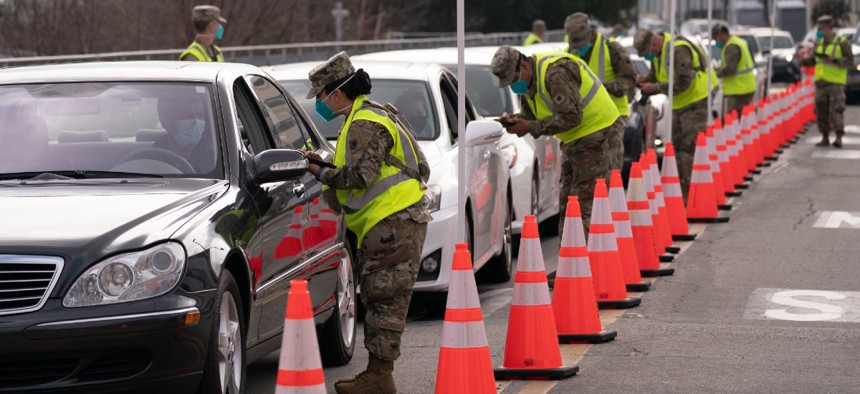DIU’s First 5G Experiment Could Be a Game-Changer for First Responders

Members of the National Guard help motorists check in at a federally-run COVID-19 vaccination site set up on the campus of California State University of Los Angeles Feb. 16, 2021. Jae C. Hong/AP
The Defense Innovation Unit is prototyping portable—and wearable—networking tools with the California National Guard so they can connect anywhere.
The Defense Innovation Unit is launching an experimental private wireless fifth-generation communications network to provide the California National Guard and other emergency responders with dependable, ad hoc mobile services anywhere in the state—and outside of existing cellular network ranges.
“This is the first effort that DIU has prototyped in the 5G arena,” DIU’s Cyber Portfolio Director Jeff Kleck told Nextgov on Friday.
Founded in 2015, the unit is meant to help accelerate the Department of Defense’s use of emerging technologies.
For this newly unveiled year-long prototyping pursuit, DIU first facilitated teaming arrangements among multiple businesses to puzzle out how to enable a next-level private 5G service. From there, DOD awarded contracts to Nokia Innovation—which will provide edge computing and frequency allocation solutions, as well as portable cellular radios and power outputs to speedily blanket an area with coverage—and Somewhere Labs. Wearable devices from the latter will help to extend the mobile network over or around terrain and in dead spots.
The next era of wireless capabilities driven by 5G is expected to be game-changing. Technology underpinning it is engineered to boost the speed and responsiveness of wireless networks in major ways. DOD is strategically steering multiple nascent initiatives to test and develop 5G applications for a wide variety of purposes. This new one led by DIU will help California-based first responders communicate safely in remote areas as they confront natural disasters like fires, storms, and earthquakes that increasingly devastate their communities.
Right now, a full 5G mobile network isn’t really possible, according to Kleck, because some industry standards are still under construction and some required components—like ultra-low power 5G—aren’t yet available. This prototype work, in his view, could lead to quicker implementation and 5G fielding without delays from ongoing spectrum policy debates.
“There is an urgent need to solve a tactical private network use-case,” he explained.
If all goes as planned, the project could eventually allow emergency responders to arrive at any site, including those outside of existing range, and access networked applications like push-to-talk voice, geolocation and live maps of their surroundings directly on their personal or government-issued mobile devices.
The first person to arrive could bring the private network along with them via a vehicle-mounted, backpack, hand-carried or wearable node.
“Once this capability is proven to be valuable and fieldable,” Kleck said, “we do expect the backhaul portions to be easily integrated into the greater DOD 5G network and across other state first responders and other operational units, both here in the U.S. and abroad where this technology is needed.”
Beyond the initial year of prototyping, DIU officials “expect the [California National Guard] will purchase mission-appropriate quantities of base stations and wearables to stock for operations,” he further noted. The guard is also anticipated to potentially buy subscriptions for a roam-in feature that allows bring-your-own-device, or BYOD, phones to preserve commercial cellular connectivity while registered to the private-5G network.
“The batch of base stations and wearables used in this prototype will be on-loan to other guard units and DOD operator partners for try-before-buy evaluations,” Kleck added. “Bear in mind that these networks are not permanent fixtures like those in fixed private-wireless installations and there is no effort involved in tear-down for relocation.”
He did not confirm the value of the contracts associated with this work, but noted that it will depend “on the extent of use across the guard and military services, and the rate of deployment.”






